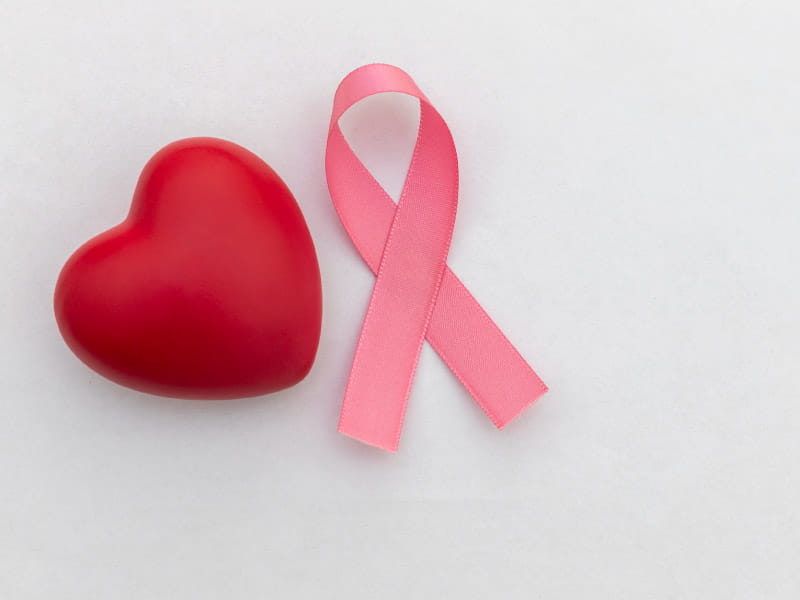How to lower heart disease and breast cancer risk at the same time
By Teresa McUsic, American Heart Association News

It turns out that many of the lifestyle behaviors that help fight off breast cancer in women also can help them avoid heart disease.
Think of it as a "double win," said cardiologist Dr. Ana Barac, director of the cardio-oncology program at MedStar Heart and Vascular Institute in Washington, D.C.
Such a win could benefit a substantial number of women. In the U.S., an estimated 9.1 million have coronary heart disease, and heart disease overall is the leading cause of death for women. In 2019, about 3.8 million women in the U.S. were living with breast cancer, with an estimated 43,250 deaths expected this year.
While some risk factors, such as age and family history, cannot be changed, here are five things women can do to lower their risk for both conditions.
What to eat – and not to eat
To prevent heart disease and breast cancer, the American Heart Association and American Cancer Society offer similar guidance for an ideal diet, which includes eating a variety of fruits and vegetables; choosing whole grains rather than refined grain products; avoiding processed meat; and limiting added sugar.
Even for women already diagnosed with breast cancer, "diet is a huge part of staying healthy," Barac said. Evidence, she said, suggests an association between a healthy diet and an improved breast cancer prognosis. For example, a 2020 study in the Journal of Clinical Oncology found that reducing fat intake and increasing vegetable, fruit and grain intake may reduce the risk of dying from breast cancer in postmenopausal women.
More clear-cut, though, is the data for cardiovascular disease, Barac said. "We have strong evidence that in people with cardiovascular disease, including coronary heart disease, eating a healthy diet improves outcomes." A 2020 analysis in the journal Nutrients found people with cardiovascular disease who followed a Mediterranean diet – focusing on vegetables, fruits, legumes, nuts, olive oil, whole grains and fish – had a lower risk of dying from any cause, including cardiovascular disease.
Maintain a healthy weight
Having obesity is a risk factor for cardiovascular disease, as well as for breast cancer after menopause, according to a 2018 AHA scientific statement about cardiovascular disease and breast cancer.
Body mass index, or BMI, is a calculation(link opens in new window) of height and weight that determines a person's weight category. Obesity is defined as a BMI of 30 or greater.
Get up and get moving
At least 150 minutes a week of moderate-intensity aerobic exercise, such as brisk walking, is recommended for adults. Unfortunately, federal survey data show only about 1 in 5 U.S. women say they meet that requirement. And research suggests getting less than the recommended amount of physical activity each week is associated with an elevated risk for both cardiovascular disease and breast cancer.
Sedentary time poses the same risks.
"If you are sitting for a long time, you need to get up and walk around," even if you exercise that day, said Dr. Tochukwu Okwuosa, a cardiologist and associate professor at Rush Medical College in Chicago. Getting up every hour for even a minute or two will benefit the body, she said.
Beware the booze (and the hormones)
The takeaway here is moderation for those who drink alcohol – and not starting for those who don't. Moderation means no more than one drink a day for women, the AHA and cancer society say.
And "make sure you don't binge," Okwuosa said. For women, binge drinking typically translates to four or more drinks in a two-hour period, according to the National Institute on Alcohol Abuse and Alcoholism.
Excessive drinking can increase the risk for liver disease, breast cancer and a range of cardiovascular problems, including high blood pressure, heart disease and stroke.
Okwuosa said women also should be aware of the risks associated with postmenopausal hormone replacement therapy, which has been linked to an increased risk of breast cancer and cardiovascular disease.
If a woman has a history of breast cancer or any cardiovascular disease, or the more risk factors she has, "then the chance that hormone replacement therapy could be not a good thing for you is higher," Okwuosa said.
Women should talk to their health care team about the risks and benefits of options for managing menopause symptoms to find the best treatment strategy for them.
Get screened
Knowing if you have high blood pressure, high cholesterol or diabetes – and then working with a health care professional to treat it – can help prevent those conditions from causing heart disease and other cardiovascular conditions.
The AHA advises blood pressure screening for adults at each regular health care visit or once a year if blood pressure is normal. It also recommends cholesterol screening every four to six years, starting at age 20, for adults at normal risk for heart disease and stroke, or more often for those at elevated risk. For diabetes, the American Diabetes Association recommends screening starting at age 35, or sooner for those at elevated risk.
Although mammograms cannot prevent breast cancer, they can help detect it early. For women at average risk for breast cancer, the cancer society recommends annual mammograms starting at age 45, with the option to start at age 40. Women 55 and older can switch to every other year or can choose to continue yearly mammograms.
Knowing your family history for breast cancer and cardiovascular problems is a big part of determining when and what type of screening you might need, Barac said.
Overall, she added, once health care professionals understand someone's personal and family medical history, "we can use lifestyle medicine, in particular exercise and diet, to empower women and prevent cancer and heart disease."
If you have questions or comments about this American Heart Association News story, please email [email protected].





